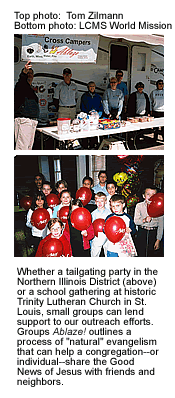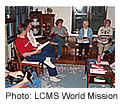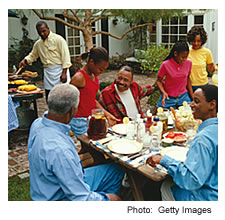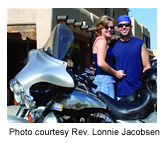by Diane Strzelecki
Developing small groups for outreach can aid a congregation’s evangelism efforts and support us individually as we speak the Good News to our unchurched friends and neighbors.
 We know that “in the beginning” God said it was not good for man to be alone. Adam needed “an help meet for him,” a partner, a helper. God gave Adam Eve. Together, Adam and Eve would tend the garden God had planted for them. Together, they would share the work and complete the tasks of life.
We know that “in the beginning” God said it was not good for man to be alone. Adam needed “an help meet for him,” a partner, a helper. God gave Adam Eve. Together, Adam and Eve would tend the garden God had planted for them. Together, they would share the work and complete the tasks of life.
In many ways, the same model applies to sharing the Good News. A partner (or two or three) can make the process a whole lot easier.
The early church understood this. We read in Acts 2:44: “All the believers were together and had everything in common” and “all the believers were one in heart and mind. No one claimed that any of his possessions was his own, but they shared everything they had” (Acts 4:32). Preaching, worshiping, praying—even eating—were done together. Their bond helped each of them grow spiritually; but more important, through the Holy Spirit, it made them an evangelistic force to be reckoned with. As a result, the church grew exponentially.
Dr. Terry Tieman, who serves double duty as director of mission revitalization for the Mid-South District and director of the LCMS Task Force on Mission Revitalization, recalls that while examining ways to multiply ministries and plant churches, the LCMS task force kept returning to a specific model for small groups. “We came to the conclusion that developing evangelistic small groups was the best way to reach more people with the Gospel,” he explains.
Out of that recognition came the movement known as Groups Ablaze!
NOT YOUR AVERAGE SMALL GROUP
Traditionally, most faith-related small groups have focused on caring for people who already belong to the church while often overlooking the people who don’t—the neighbors, friends, and family members who really need an introduction to Jesus Christ. Not so with the Groups Ablaze! model.
Rev. David Born, LCMS World Mission regional director for the northeast United States, acknowledges that reaching out can be difficult.
“It’s hard for all of us,” he says. “A lot of people start feeling downright guilty. They know they should get out there and witness, but they feel inadequate. They don’t know where to start. There are congregations that know they need to reach out, but they really don’t know how to do it or have resources that help them feel confident doing it. Groups Ablaze! is designed for them.”
Launched in 2006, Groups Ablaze! includes a series of six-week studies. It makes the case for why the church is called to outreach, explores the dynamic of prayer in reaching the lost, outlines the process of natural evangelism, and describes what to do when a “seeker” comes to your group.
“We really want congregation members to break out of the box where they only know people in the church,” says Tieman, who also leads the Transforming Congregations network, which will kick off officially in January. The network will help church leaders begin their own revitalization process through consultations and learning communities.
“We advocate Groups Ablaze! as one part of a mission revitalization process for every church,” Tieman says. “What it does is help the pastor and the people see that it’s not about us, it’s about reaching people for God and being equipped to reach those who are lost.”
Born even advocates some radical changes: “We would like people to consider freeing themselves from some of their current relationships with people who don’t need to hear the Gospel again so that you can start getting into the community.”
INTRODUCING Groups Ablaze!
 Dr. Jack Giles, Congregational Services executive focusing on small-group development for the Northern Illinois District (NID), notes that his district introduced Groups Ablaze! by means of a districtwide Ablaze! rally.
Dr. Jack Giles, Congregational Services executive focusing on small-group development for the Northern Illinois District (NID), notes that his district introduced Groups Ablaze! by means of a districtwide Ablaze! rally.
“We really wanted to do more of a campaign effort, so that’s when we started looking at a rally to launch the process, getting as many congregations on board as possible,” he says. “We offered the same Groups Ablaze! lessons as developed by Synod, although we did revise the material and included a 10- to 12-minute teaching message by six NID pastors as a ‘leader lifter’—some words of encouragement for the member leading the study—as part of a ‘teaching DVD.’”
Giles adds that the district provided the DVD to each group using the Ablaze! materials.
“Leading up to that, we offered four one-day training events to help congregations launch the new movement,” Giles says.
The fall 2006 rally served as the big kickoff for the NID campaign. “Our goal: Try to get 72 congregations, 720 small groups, 7,200 people involved,” Giles says.
Why 72, 720, and 7,200? Giles notes that when the Groups Ablaze! Implementation Team was first trained and began praying about how best to implement Groups Ablaze! in the NID, they kept landing on Luke 10:
“After this the Lord appointed seventy-two others and sent them two by two ahead of Him to every town and place where He was about to go. He told them, ‘The harvest is plentiful, but the workers are few. Ask the Lord of the harvest, therefore, to send out workers into His harvest field’” (Luke 10:1–2 NIV).
Today 80 congregations in the NID are involved in the Groups Ablaze! effort, for a total of 621 groups and 5,864 people.
EMBRACING THE CHALLENGE
Once equipped, Groups Ablaze! members are encouraged to develop relationships with unchurched friends, co-workers, and neighbors, eventually, as friends, earning the right to invite them to nonthreatening, home-based, small-group gatherings. Simply put, it’s putting outreach back in the hands of the congregation, which inspires people and can even reawaken their faith-life.
“This is a lifestyle thing. It’s not a program; it’s a process,” Born says. “We’re really talking about changing lifestyles on an individual basis and changing the congregational culture.”
 There are many opportunities for developing such relationships, Born adds. He mentions group events, community-service projects, interest groups. “You could even start a club over some secular hobby you have,” he says. “Every gathering is an opportunity for sharing the Gospel with people. If you focus on building relationships with non-Christians, they are going to notice who we are.”
There are many opportunities for developing such relationships, Born adds. He mentions group events, community-service projects, interest groups. “You could even start a club over some secular hobby you have,” he says. “Every gathering is an opportunity for sharing the Gospel with people. If you focus on building relationships with non-Christians, they are going to notice who we are.”
Rev. Lonnie Jacobsen, pastor of Christ Lutheran Church in Arlington, Tenn., notes that committed and focused lay leaders are critical to the process. “I think a lot of congregations say, ‘Well, the pastor can run all these groups,’” he says. “The notion of ‘the priesthood of all believers’ is a part of the Gospel that we generally don’t do very well, but it’s absolutely necessary for the Groups Ablaze! model to work.”
When he preaches on the topic of outreach, Dr. Scott Rische, pastor at First Lutheran Church in El Cajon, Calif., always asks several questions.
“I ask people, ‘Would you rather tell people the Good News by yourself or with a group of people? Would you rather do some kind of mission work or community service alone or with a group of people?’ ”
Indeed, it all goes back to having helpers and partners, as the apostle Paul acknowledged in his letter to the Philippians: “I thank my God every time I remember you. . . . I always pray with joy because of your partnership in the Gospel from the first day until now” (Phil. 1:3–5).
And prayer, Rische stresses, is the place to begin regardless of the circumstances. “Evangelism begins on our knees. We need to talk to God about lost people before we can talk to lost people about God.”
Groups Ablaze! – From the Beginning
 Rev. Lonnie Jacobsen, pastor of Christ Lutheran Church in Arlington, Tenn., notes that the Groups Ablaze! model perfectly describes his church.
Rev. Lonnie Jacobsen, pastor of Christ Lutheran Church in Arlington, Tenn., notes that the Groups Ablaze! model perfectly describes his church.
“We’ve been using the reproductive concepts of Group Ablaze! from the very beginning of the life of our congregation,” Jacobsen says.
The church was founded at Easter 2002, a daughter congregation was “birthed” in 2004, and a satellite was launched last year—with all the growth coming from the small groups.
“Our groups are each just like a church, and at all levels they are reproducing themselves,” Jacobsen says. “We do things together, we do things as teams, then groups reproduce and ultimately there’s opportunity for a new church to begin. It’s part of our culture.”
Another important part of Christ Lutheran’s culture is that member homes are places for ministry—and so are restaurants, coffee shops, and firehouses.
“When our church building was nearly destroyed by a fire, and we had no place to worship, we did it anyway,” Jacobsen says. “Worship was held in about five different places. Our elders split off and led the Communion at each location so everyone could worship ‘corporately’ until we found a place to rent. We didn’t just go to another church; we didn’t just wait it out and skip that week: we went to worship in our homes.”
Even something as simple as beginning a Bible study at a workplace can lead to something big, if the person leading it has been empowered. “A small ‘workplace group’ at one nursing home has developed into a twice-monthlyworship service,” Jacobsen says. “We have about 50 to 100 residents who are bedridden or can’t make it to the chapel who participate through closed-circuit TV. And it all began with something as simple as starting a small-group Bible study.”
Despite the success of megachurches, Christ Lutheran is determined to simply reproduce itself over and over.
“Part of what we did when we started this church was to intentionally buy a building that was rather small,” Jacobsen says. “After about two years we were bursting at the seams, which meant we had to start another church.”
Because their vision doesn’t include a megacampus—they didn’t buy 12 acres of land to create a megachurch—they have to reproduce, Jacobsen adds.
“Now we’re packed again, with two services full, and we have the plans written up to begin another church,” he says.
Jacobsen notes that when visitors or new members come, they get excited about the possibility of buying property and building a new facility.
“Our members say no, that’s not what we do,” he says. “We’re committed to, and have bought into, the whole idea of reproducing in and with growing. This won’t be a megachurch, something other people might see as a successful church. From the beginning we’ve proclaimed the concept of sending people out to start a new church, so we have to live it out.”
Over the last five years, Christ Lutheran has celebrated about 100 baptisms and adult confirmations. With a total weekly combined worship attendance of approximately 250 from all locations, the numbers are impressive.
“It’s a very high number of conversion growth, which is very encouraging,” Jacobsen says.
*************************
For congregations or individuals eager to explore what Groups Ablaze! can mean for them, the LCMS World Mission training center has the resources, materials, and personal assistance to make it happen. Visit www.groupsablaze.org to learn more, order study materials, and make the personal contacts you need to use small groups for outreach in your church. You may also contact your LCMS district office to see if your district is participating in the Groups Ablaze! initiative.
If your district is not yet a Groups Ablaze! participant, contact Rev. David Born, LCMS World Mission regional director, northeast United States, at David.Born@LCMS.org.





